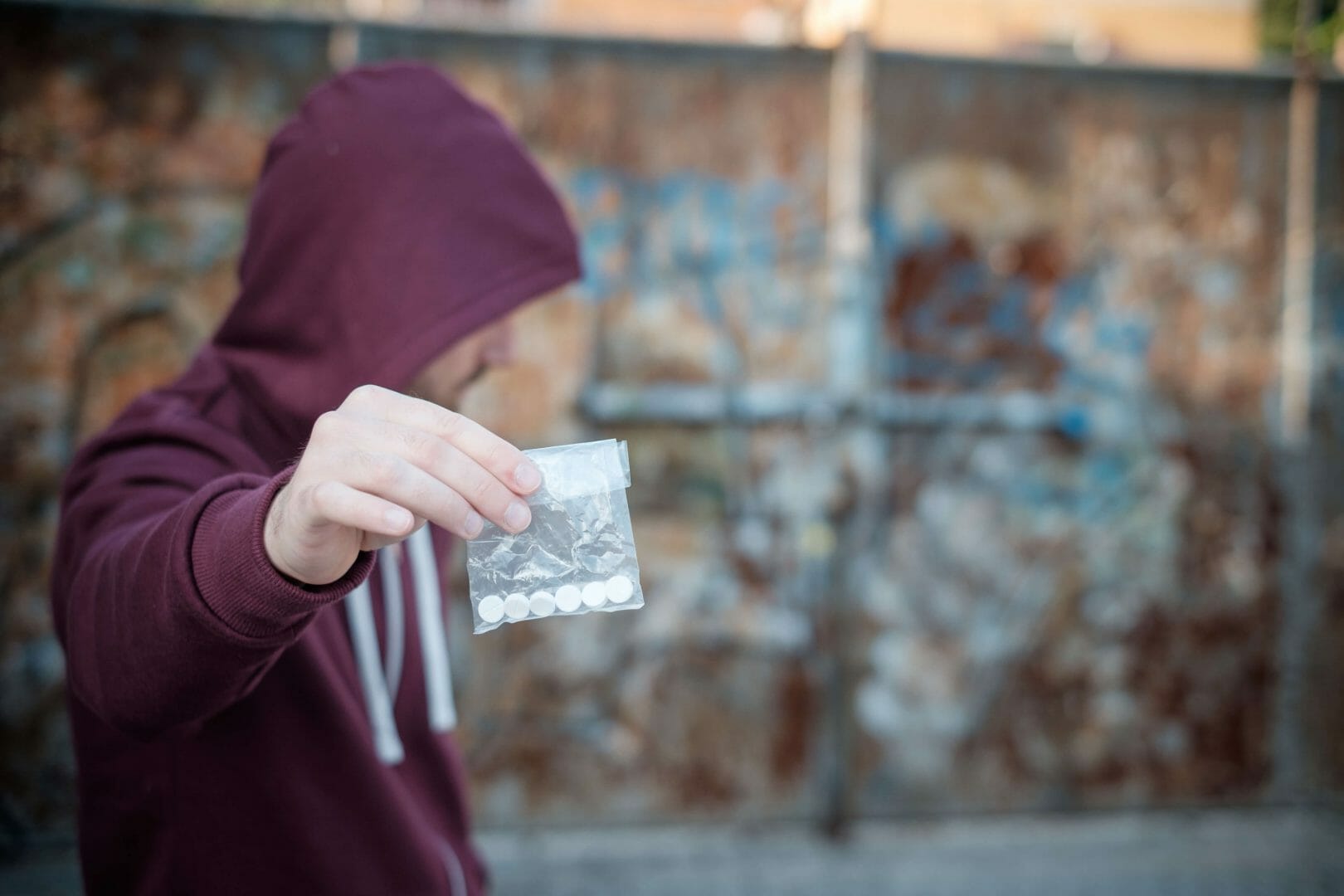The US Opioid Crisis is one of the worst man-made disasters of all time and should serve as a warning to every country of the importance of responsible prescribing and stringent regulatory measures. While several opioids have played their part in the epidemic, few are synonymous with the resulting death and destruction as oxycodone. This powerful opioid, often prescribed for pain management, has been widely misused, leading to a surge in addiction, overdoses and fatalities. While the UK has not seen the same levels of addiction and fatalities as the US, the addictive potential of oxycodone must be recognised and managed to prevent similar outcomes as those seen across the Atlantic.
Call our admissions line 24 hours a day to get help.
What is Oxycodone?
Oxycodone is a semi-synthetic opioid analgesic used to relieve moderate to severe pain following surgery or an injury. It may also be prescribed for chronic pain but only after non-opioid pain medications are tried and found to be ineffective.
Oxycodone can be administered orally, rectally, intravenously or through an epidural. Intravenous administration relieves pain faster than oral or rectal administration. IV oxycodone is usually given in a hospital emergency room or after surgery. Intravenous oxycodone is also used in hospice facilities to relieve severe pain and control rapid or laboured respiration.
Oxycodone is present in numerous medications from several manufacturers and sold under a variety of brand names, including:
Oxycontin
Oxaydo
Oxycodone CR
Endocet
Percodan
Percocet
Roxicet
Roxicodone

A brief history of oxycodone
Oxycodone has been used in medical treatment since it was first synthesised in Germany in 1917, with the scientists responsible for synthesis initially claiming it was not addictive. This proved to be untrue, but the claim was repeated in 1996 with the production of OxyContin, a slow-release version of oxycodone. OxyContin’s approval by the FDA would later be described as “the greatest mistake in medical history” by the organisation’s former director, and it would be the cause of millions of addictions across the US and tens of thousands of deaths.
Oxycodone, particularly in this slow-release form, was prescribed to patients with little medical supervision. Many of these individuals’ conditions did not warrant such a powerful opioid, and they soon became addicted. Some spent their life savings on prescription opioids; others, when oxycodone was unavailable, turned to drugs like heroin, developing addictions with serious health and personal consequences.
Recognising the potential for this harm, in the UK, Oxycodone is a Class-A drug, the most serious classification available. Unlawful possession is punishable by an unlimited fine and a prison sentence of up to seven years, while illegal supply carries a maximum sentence of life in prison.
How does oxycodone work?
Oxycodone works by binding to specific receptors in the brain and spinal cord, known as opioid receptors, which are part of the central nervous system. When oxycodone attaches to these receptors, it produces two main beneficial effects alongside a number of side effects:
1. Pain relief
Oxycodone primarily works by altering the perception of pain in the brain. It mimics the action of naturally occurring pain-reducing chemicals called endorphins. These chemicals operate within the pain pathways of the brain and spinal cord, and when oxycodone binds to the opioid receptors, it can significantly reduce the sensation of pain.
2. Cough suppression
Oxycodone can also suppress the cough reflex with a direct effect on the cough centre in the brain’s medulla. Due to oxycodone’s addiction potential, it is never prescribed for this in the UK.
Oxycodone side effects
Oxycodone, like all opioids, can cause a range of side effects. These effects vary among individuals and can be influenced by factors like dosage, duration of use and individual sensitivity. Common oxycodone side effects include:
- Gastrointestinal issues such as nausea and vomiting
- Constipation
- Drowsiness and sedation
- Dizziness
- Lightheadedness
- Itching and rash
- Dry mouth
- Urinary retention
- Respiratory depression
- Mental fog
- Mood changes
Call our admissions line 24 hours a day to get help.
How does oxycodone addiction develop?
There are various ways that oxycodone is abused. First, oxycodone can produce feelings of euphoria and a sense of well-being, which leads people to abuse it recreationally. Second, individuals may self-medicate with oxycodone for pain or mental health issues or even start misusing it after originally being prescribed the drug for genuine reasons. Oxycodone abuse and misuse can occur in several ways, such as taking higher doses than prescribed, taking the medication more frequently than directed or using it in a way not intended, such as crushing pills to snort or inject the powder.
Oxycodone’s effects on the body are dose-dependent, meaning higher doses will have more pronounced effects. However, tolerance to opioids can develop with regular use, meaning higher doses of oxycodone start to be taken over time to achieve the same level of pain relief.
Once oxycodone dosage and frequency increase, with so much of the drug constantly present, the body and brain begin to rely on oxycodone for normal functioning. This dependence can lead to oxycodone withdrawal symptoms when the drug is not available, further compelling individuals to continue using oxycodone to avoid discomfort. Common oxycodone withdrawal symptoms include:
Over time, this cycle of tolerance, dependence and oxycodone withdrawal can lead to addiction, where seeking and using oxycodone becomes a primary focus. The compulsion can override everything else in a person’s life, with the individual taking oxycodone regardless of the negative consequences to their health, relationships and personal life.
Oxycodone addiction symptoms
There are various oxycodone addiction symptoms and signs which indicate there is a problem. Early identification of these symptoms can be key in seeking timely treatment and support. Some common oxycodone addiction symptoms and signs include:
- Trying to illegally obtain a prescription for oxycodone or attempting to acquire the drug via other illicit means
- Borrowing or stealing money or goods to get oxycodone
- Stealing oxycodone that has been prescribed to someone else
- Missing work or school or experiencing declining performance
- Using oxycodone when it is obviously risky or reckless to do so
- Using oxycodone even after experiencing negative outcomes
- Repeated attempts to cut down or control the use of oxycodone without success.
- Giving up important social, occupational or recreational activities because of oxycodone use.
The dangers of oxycodone addiction
The health, personal and social effects of oxycodone addiction are profound and multifaceted, impacting every aspect of an individual’s life as well as their families, friends and wider society. These include:
Health effects
- Physical health decline: Chronic use of oxycodone can lead to a range of physical health issues, including liver and kidney damage, gastrointestinal problems and a weakened immune system.
- Increased risk of overdose: Addiction leads to taking higher doses of oxycodone, increasing the risk of oxycodone overdose and severe respiratory suppression. This is an incredibly dangerous condition where breathing slows or even stops entirely, leading to hypoxia (insufficient oxygen reaching the brain). Hypoxia can have short and long-term neurological and psychological effects, including permanent brain damage, coma and even death.
- Mental health issues: Oxycodone addiction is associated with an increased risk of new or exacerbated mental health disorders, including depression, anxiety and, in some cases, psychotic symptoms.
Personal and social effects
- Impact on judgement and decision-making: The influence of oxycodone can impair judgement and decision-making abilities, leading to poor choices and dangerous behaviours.
- Relationship strain: Personal relationships often suffer, with increased conflict, breakdown of trust and potential estrangement from family and friends.
- Work and financial issues: Oxycodone addiction can lead to job loss, decreased productivity, significant financial strain, bankruptcy and even homelessness due to the cost of obtaining the drug and potential legal issues.
- Legal problems: Illegal possession, supply and production of oxycodone are all serious offences with severe legal penalties.
- Stigma and discrimination: People with oxycodone addiction often face social stigma and discrimination, which can hinder their willingness to seek help and access treatment.
- Community impact: Widespread oxycodone addiction can have broader effects on communities, as seen in many places in the US affected by the Opioid Crisis. This can include increased healthcare costs and extra burden on law enforcement and social services.
Call our admissions line 24 hours a day to get help.
Risk factors for developing an oxycodone addiction
Various factors can increase the likelihood of someone developing an addiction to oxycodone. Understanding these risk factors is crucial for both individuals taking oxycodone and their caregivers, as it can inform better management and prevention strategies.
Breaking physical dependence through oxycodone detox
Oxycodone detox is the first stage of oxycodone addiction treatment and usually takes place in a hospital or inpatient rehab centre. This is a crucial stage as it allows the body to clear oxycodone from the system and break physical dependency. Medical detox involves 24/7 supervision and support and often the administration of drugs such as buprenorphine or methadone to relieve oxycodone withdrawal symptoms.
Addressing oxycodone addiction causes through rehab therapy
Oxycodone rehab therapy involves a combination of different therapeutic modalities, enabling the individual to identify and work through the underlying causes of addiction. These include:
Cognitive behavioural therapy
Cognitive behavioural therapy, or CBT, is a common therapy used for substance disorder treatment. CBT helps individuals define the thoughts, feelings and actions that trigger a desire to use drugs like oxycodone so they can be managed more effectively.
Individual therapy
Individual therapy focuses on the specific causes and effects of each person’s addiction. By working closely with a therapist, individuals can begin to heal and build a new life from solid foundations.
Family therapy
Family circumstances often play a large role in addiction, while the effects of oxycodone abuse can impact loved ones enormously. Family therapy helps to repair relationships and teach loved ones what the individual in rehab is going through.
Group therapy
Group therapy also addresses the triggers and thoughts that cause cravings, but it takes place in a group environment. The benefit of group therapy is peer support and the opportunity to discuss thoughts, problems, history and emotions with others sharing the same experiences.
Holistic therapies
Holistic therapies treat substance abuse with an integrated physical, mental and spiritual approach. Common practices include acupuncture, massage, yoga, meditation and nutritional therapy.
Post-rehabilitation support for oxycodone addiction
Recovery from oxycodone is a continuous process that requires ongoing commitment and a well-thought-out relapse prevention plan. This plan may include strategies such as:
- Attending aftercare for ongoing support and accountability
- Learning to recognise and deal with addiction triggers
- Leaning on a support network during difficult moments
- Staying mentally and physically healthy
- Taking up new healthy hobbies and activities
- Practising meditation, mindfulness and other stress management techniques
- Joining a local recovery support group like Narcotics Anonymous
Get help for oxycodone addiction today

Oxycodone addiction can have devastating consequences, so early intervention and professional treatment are crucial. Anyone who is struggling with addiction should contact their GP or a professional addiction treatment centre immediately to begin the recovery process and potentially save their life.
Call our admissions line 24 hours a day to get help.
FAQ’s
No matter where you live, there is a drug rehab center that can help you overcome your addiction. We'll help you find it.
Select a County








